Green Card Application
Learn more about green card applications and their associated forms and processes.
What is Form I-485 Used For?
What is Form I-485 used for?
Last Updated: February 5, 2020.
Form I-485, Application to Register Permanent Residence or Adjust Status, is used to either register for permanent legal residence in the United States or adjust to permanent resident status. Adjusting to permanent resident status simply means obtaining a green card (i.e. permanent legal residency) without having to return to your home country if you’re already in the United States.
While Form I-485 is a required step on your path to legal citizenship, it isn’t the only step. In fact, you will need other completed forms and evidence depending upon your unique situation. For example, you will need a completed Form I-130 if you are getting residency through a family member who is already a citizen or lawful permanent resident of the United States.
This Form is filed with U.S. Citizenship and Immigration Services (USCIS). While your family member is responsible for Form I-130 to establish a familiar connection that enables you to take the next step in the immigration process with Form I-485, you are responsible for the completion and filing of Form I-485.
What Evidence Must You Provide With Form I-485?
Evidence required for green card applications.
Last Updated: February 5, 2020.
Along with a fully completed and signed Form I-485, there is evidence that you must include to be considered for lawful permanent residency or to adjust your status.
You can upload all required documentation within your SimpleCitizen account:
Criminal History
What you must submit will vary depending upon your previous offense:
- Arrested and Detained With No Filed Charges – Include an original, official statement by the arresting agency or a court order confirming that no charges were filed.
- Arrested or Detained and Charges Were Filed or Were Filed Without an Arrest – Include an original or court-certified copy of the entire arrest record and/or disposition (i.e. the record of the court’s final decision of the criminal charge).
- Convicted or Placed in an Alternative Sentencing or Rehabilitative Program (i.e. Drug Treatment, Community Service, etc.) – Include an original or court-certified copy of the sentencing record for each incident and evidence that you completed your sentence. This evidence may include:
- An original or certified copy of your probation or parole record; or
- Evidence that you completed your alternative program.
- Vacated, Sealed, Expunged, Removed, or Set Aside Arrests/Convictions – Include an original or court-certified copy of the court order used to vacate, seal, expunge, remove, or set aside the arrest or conviction or an original statement from the court that there is no record of the arrest or conviction.
There is no need to submit evidence for traffic fines or incidents that didn’t involve an arrest as long as the fine was less than $500 and/or points on your driver’s license. However, you must submit evidence if the traffic incident was related to alcohol or drugs.
Birth Certificate
You must include a copy of your foreign birth certificate or other birth record with Form I-485.
Copy of Passport Page With Nonimmigrant Visa
If you have a nonimmigrant visa(s) from a U.S. Embassy or consulate that you received outside the United States within the past year, you must include photocopy(ies) of the page(s) with your Form.
Photos
You must include two identical color photographs of yourself taken within 30 days of your application with the Form.
Each photo must:
- Have a white to off-white background
- Be printed on thin, glossy paper
- Be unmounted and unretouched
You may also use passport photos that follow the three bullet points above and meet these additional criteria:
- Measure 2 inches by 2 inches
- Be a full face, frontal view where your head height measures 1 inch to 1 3/8 inches from the top of your hair to the bottom of your chin
- Bare head, unless headwear is required by your religious order
Biometrics
If you are between the ages of 14 and 79, fingerprints are required by USCIS biometrics services. You will submit your fingerprints once you have filed your application.
To do so, USCIS will contact you in writing to let you know where and when you must go to be fingerprinted. If you do not follow these instructions, your Form may not be approved.
Police Clearances
Police clearances are sometimes required for individuals seeking an adjustment of status as a member of a special class outlined in an I-485 supplementary form. You must read the instructions on the form to see if you need police clearances with your application.
Medical Examination
Some individuals must submit a medical examination via Form I-693, Report of Medical Examination and Vaccination Record:
- General – You must include Form I-693 with Form I-485, unless you are a refugee.
- Refugees – If you are applying for adjustment 1 year after being admitted to the U.S. as a refugee, you must only submit the vaccination portion of Form I-693 (pages 1, 4, and 6) with your application. You must submit the entire report only if you had a Class A condition included on your overseas medical exam.
- Fiancés – If you are a K-1 fiancé or K-2 dependent who received a medical examination when obtaining your nonimmigrant visa, you only need to submit the vaccination portion of Form I-693 with your application.
- Exempt – If you are applying to create a record as a lawful permanent resident under section 249 of the INA as someone who has resided in the U.S. since January 1, 1972, you do not need to submit a medical examination with your application.
Form G-325A (Biographic Information Sheet)
If you are between 14 and 79 years old, you must include Form G-325A with your application.
Affidavit of Support/Employment Letter
You must submit an Affidavit of Support (Form I-864) if you’re filing Form I-485 as the fiancé of a U.S. citizen or lawful permanent resident, through Form I-130 (relative petition), or Form I-140 (an employed-based visa petition).
You must include an employment letter with Form I-485 if you are using an employment-based visa petition to enter the U.S. This letter must be sent on your employer’s letterhead and confirm that the job is available and the salary you will be paid.
Eligibility
Depending on how you enter the United States, your eligibility evidence will differ:
- Immigrant Petition – Include a copy of the approval notice of your immigrant petition that shows a visa number is available to you. If you do not have this, you may include a complete relative, special immigrant juvenile, or special immigrant military petition that will make a visa number available to you.
- K-1 Fiancé – Include a copy of the fiancé petition approval notice, a copy of your marriage certificate, and Form I-94, the Arrival/Departure Document.
- Asylum – Include a copy of the letter or of Form I-94 showing the date you were granted asylum.
- Continuous Residence Since Before January 1, 1972 – Include copies of evidence showing you have been residing in the U.S. since before January 1, 1972.
Cuban Citizenship or Nationality
You must include evidence of your citizenship or nationality. Examples of acceptable evidence include copies of your passport, birth certificate, or other travel documents.
As a Spouse or Child of Another Adjustment Applicant or Permanent Resident Through Immigrant Visa Issuance
You should file your application with the other applicant and with:
- Evidence that the applicant’s application is currently pending or has been approved; or
- Evidence that your spouse or parent was granted permanent residence based on an immigrant visa.
If you are applying as a spouse, you must include a copy of your marriage certificate and documents showing that all previous marriages have been legally ended.
If you are applying as a child, you must attach a copy of your birth certificate. If the applicant isn’t your parent, you must submit evidence (including marriage certificates, legal endings to all existing marriages, and the adoption decree) to prove that you are the applicant’s legal child.
Indochinese Parolee
Along with all other evidence indicated above, you must include:
- Evidence that you are a citizen or native of Vietnam, Kampuchea (Cambodia), or Laos;
- Evidence that you’ve been paroled into the U.S. from Vietnam under the Orderly Departure Program (ODP), from a refugee camp in East Asia, or from a displaced persons camp administered by the United Nationals High Commissioner for Refugees (UNHCR) in Thailand before October 1, 1997; and
- Evidence that you have physically been in the U.S. prior to and on October 1, 1997.
Evidence of parole may include:
- Parole authorization letter
- Transportation letter
- Arrival/Departure Record (Form I-94)
If you don’t have any of these records, you may need to request this information through the Freedom of Information Act (FOIA). If you still cannot find your records, you may include an affidavit (sworn oath) with Form I-485 requesting that DHS search its files to locate any existing proof that you were paroled as part of the programs listed above.
Evidence of physical presence in the U.S. during the time period indicated above may include documents issued by a federal, state, or local authority, such as:
- Immigration records
- School records
- Military records
- State driver’s license or other identification card
- Utility bills
- Medical records
- Deeds
- Mortgages
- Contracts
- Insurance policies
- Receipts
- Any other evidence you believe proves your physical presence
Any evidence must be in your name and bear the signature, seal, or other official marks of an issuing authority (if from an official agency) and be dated no later than the required date.
How Much Does it Cost to Submit Form I-485?
Learn about the costs associated with filing Form I-485.
Last Updated: January 2023.
If you are filing the I-485 (Adjustment of Status) application, you will need to pay the government fees. You will submit these fees with the application when you mail it to USCIS. The amounts you will pay will vary based on your circumstances. This article explains how to calculate how much to pay.
I-485 Fee Amounts
Filing Form I-485 typically costs $1,440. For children who are under the age of 14 and who are filing with at least one parent, the fee is only $950. There are additional filing categories under which Form I-485 fee may be waived.Here are some examples to help walk you through the fee rules:
- A 5-year-old child applying for the I-485 at the same time as their mother would pay $950 for their I-485.
- An 81-year-old applicant being petitioned by their US Citizen child would pay $1,440 for their I-485.
- A 22-year-old applicant applying for the I-485 through marriage would pay $1,440 for their I-485.
- A 13-year-old applicant whose parents were not applying at the same time as them would pay $1,440 for their I-485.
If you still need clarification about how much to pay, you can also use the USCIS Fee Calculator to double-check. USCIS changes its fees periodically, so double-checking the fee calculator is always a good idea.
Please note: Depending on which forms you are filing at the same time as Form I-485, additional filing fees may be associated with submitting your application. The most common fees are the filing fee for Form I-130, Form I-765, and Form I-131. For information on how to pay the I-485 fees, see the following article. With all of our packages, we include detailed instructions and support with the entire application process, including paying the fees to USCIS. We would be happy to help you prepare your I-485 application! Click here to get started.
I-864 Affidavit of Support and Financial Sponsor for Green Card
What a joint sponsor is, their requirements, and when a joint or household sponsor is needed.
Last Updated: May 25, 2023.
Part of the green card process for family-based green card applications is filing the Form I-864, Affidavit of Support. Form I-864, Affidavit of Support is one of the most difficult forms to file in the Green Card application process. It can be difficult to understand why it exists, what USCIS is looking for, when it is required, and for whom. This article will provide you with details regarding what a financial sponsor is, what the requirements are for a financial sponsor and how USCIS determines if someone meets the requirements, and when a household member or joint sponsor is needed.
What is Form I-864, Affidavit of Support?
Form I-864 is a contract between the person who files of the form (the sponsor) and the United States Government. Anyone who fills, signs, and submits the form on behalf of an intending immigrant becomes a sponsor and is held to this contract.The primary aim of this contract is to provide USCIS with proof that the sponsor has sufficient financial means to support the applicant, in a case where they may ever need financial support By signing Form I-864, the sponsor is agreeing to use their financial resources to support the intending immigrant affidavit, if it becomes necessary. One of the primary reasons USCIS requires this is to protect the U.S. government from people entering the United States and then using government financial resources. Another important point to be aware of is that by filing this form, the intending immigrant may become ineligible for certain means-tested (finance-based) public benefits offered on Federal, State, or Local levels. Should the applicant/beneficiary ever use these public benefits, it is within the rights of the agency providing the benefit to require the sponsor to repay the costs of the benefits used, as per the conditions of the contract. In cases where the benefit is not repaid, the agency is able to sue the sponsor . While this is extremely uncommon, it is a risk all sponsors should be aware of.For more information regarding which benefits are considered, please see the I-864P Poverty Guideline page.
How Long does the I-864 Contract Last:
The contract between the sponsor and the US government begins the moment USCIS receives the Form I-864 and does not end until at least one of the following conditions has been met:
- The beneficiary gains U.S. Citizenship
- The beneficiary has worked in the US for at least 10 years
- The beneficiary leaves the US permanently and loses their Permanent Resident status.
Who Files Form I-864, Affidavit of Support?
Form I-864 must be submitted by all applicants seeking a green card benefit through connection to a family member. In other words, all family-petitioned (and even some employment-petitioned) applications are required, by law, to include Form I-864 at some point throughout the green card application process. For individuals going through the consular process abroad, this is done along with the DS-260. For those applying to adjust status within the United States, this is done along with submission of the Form I-485.All family-based petitioners, regardless of income or employment, are required to file Form I-864 on behalf of the relative they are petitioning. In other words, they must accept a degree of financial responsibility for that relative by submitting Form I-864. However, in situations where the petitioner does not meet the income requirement, USCIS requires that another sponsor be added. This individual can be either a household member of the petitioning sponsor or they can be a joint sponsor. Anyone whose income is being used to meet the income requirements set forth by USCIS automatically accepts the agreed upon financial responsibility for the applicant/beneficiary. There are certain exemptions to the rules listed above, which can be found on pages 1 and 2 of the Form I-864 Instructions.
Do I meet the requirements to be the financial sponsor?
As mentioned above, it is important to remember that the petitioner via Form I-130 is REQUIRED to file the financial affidavit regardless of if they meet the financial requirements or not. By doing so they are accepting the financial responsibility over the intending immigrant. However, if the financial requirements are not met another sponsor will need to be added in addition to the petitioning sponsor. Let’s take a deeper look into what that looks like.
There are four requirements to qualify as a financial sponsor:*
- They must be a US citizen or a legal permanent resident (green card holder)
- They must be at least 18 years old
- They must be domiciled in the US
- They must have an annual income over 125% the federal poverty level. This amount varies depending on family size. You can check the USCIS guidelines here. In 2022 the required income for a household of 2 is $24,650.
*Please note that despite what is outlined in USCIS policy, we are seeing the following circumstances result in greater scrutiny from USCIS and higher rates of receiving a Request for Evidence even if the sponsor’s income was 125% or more of the poverty line:
Income Close to the Required Level/Lack of Proof
- USCIS always highly scrutinizes proof of income, but especially if the income is close to the required income. In these cases a detailed letter from the employer and six months of pay stubs showing consistent income can help, but in some circumstances a joint sponsor may also be recommended.
Self- Employed Sponsors
- Self-employment is often harder to prove to USCIS. Where typical W2 employment typically can prove both historic and future income via pay stubs and employer letter, self-employment often shows historic income, but doesn’t create as strong of proof of future income. If USCIS feels that the income from self-employment is not stable enough to sponsor an immigrant long-term they are very likely to send an RFE requesting a joint sponsor.
Retired Sponsors
- Retired sponsor’s must add sufficient evidence of their retirement income via retirement or Social Security statements. Inability to provide these documents will lead to greater scrutiny.
Lack of Income History
- Even if a sponsor’s current income meets the level required by USCIS, a lack of strong income history may cause USCIS to doubt the sponsor’s ability to financially provide. It is especially common if the total income from the most recent tax year was below 125% of the poverty guideline.
In instances where the sponsor falls into one of the four listed categories, we have seen applicants experience the most success when they add an additional sponsor to the application.
Additional Sponsors
There are two main ways in which someone can be added as an additional sponsor to an application. We are going to take a look at both types of sponsors so that it is clear who qualifies as an additional sponsor and which type of additional sponsor they would be.
Household Member
A household member is a sibling, parent, or adult child with the same principal residence as the petitioning sponsor. When their income is used for financial support on the application they file the I-864A, Contract Between Sponsor and Household Member. The difference of filing as a household member instead of a joint sponsor is that instead of having to independently meet the income threshold, their income will be combined with the petitioning sponsor and USCIS will make their decision based on the total household income.For example, If Robert is sponsoring his wife for a green card and has an annual income of $10,000 and his father, Mark, who lives with them, agrees to financially sponsor as well then his income of $40,000 would be added together and USCIS would consider the $50,000 of household income.
Joint Sponsor
A joint sponsor is someone who helps the primary sponsor to satisfy the financial requirements of sponsorship. While both the petitioning sponsor and the joint sponsor will be required to file Form I-864, USCIS will make a decision regarding the joint sponsor’s income independent of the petitioning sponsor. For example, If Robert is sponsoring his wife for a green card and has an annual income of $10,000 and John, a family friend, agrees to financially sponsor as well and his income is $40,000 then, when reviewing John’s form, USCIS would consider only John’s income $40,000 when deciding whether he is eligible to act as a sponsor.
Conclusion
The financial sponsorship forms are considered to be some of the most complicated and highly scrutinized by USCIS. It’s important to be thorough and provide evidence that is as clear as possible. Having the guidance of a licensed immigration attorney can be extremely helpful, especially when filing form I-864. If you are interested in getting the peace of mind that comes from legal support without the high cost of a conventional immigration lawyer, SimpleCitizen partners with a network of independent attorneys who offer their legal guidance and recommendations.Here at SimpleCitizen we offer the ability to send joint sponsor’s a private link that will retrieve all of the information needed and complete the required documents for the sponsor.If you have any other questions about a sponsor feel free to use our live chat.
Additional Resources
Click here for information about sponsors from the USCIS website.
Form I-485 Step-by-Step
Learn more about how to File Form I-485.
Last Updated: January 15, 2020.
What is the Form I-485?
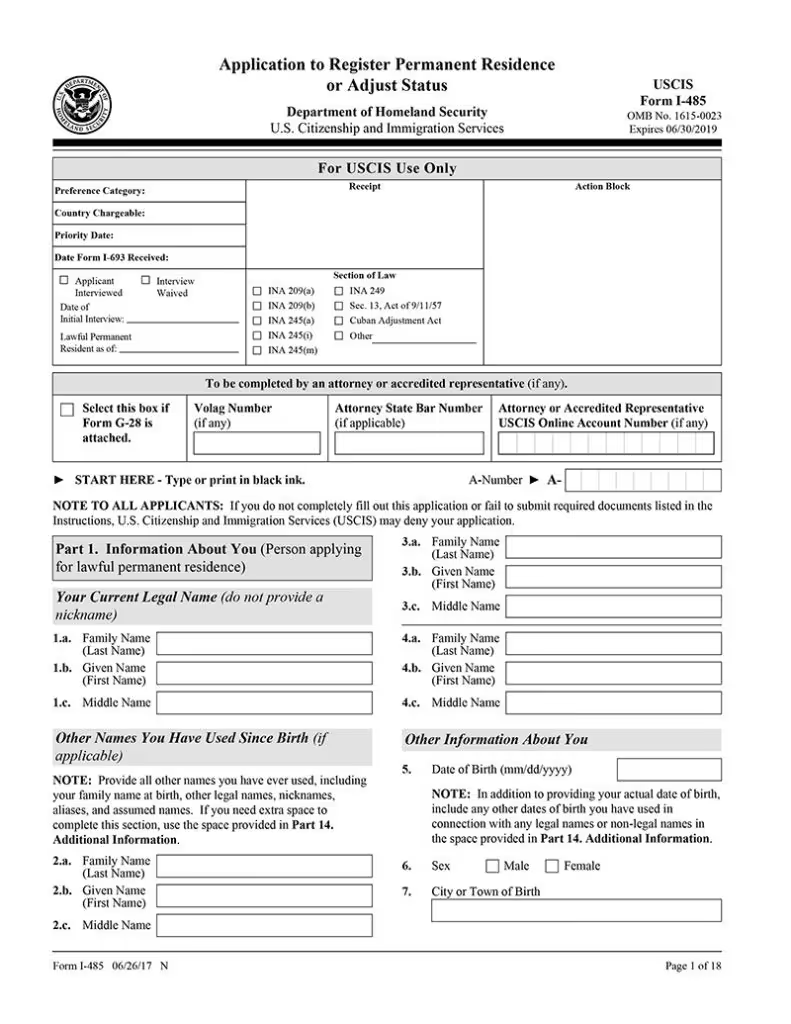
The Form I-485, Application to Register Permanent Residence is the form used to apply for Lawful Permanent Residence (also known as holding a green card).
"Adjustment of status" (AOS) is the process by which an immigrant applies to adjust his or her status from "nonimmigrant" to "immigrant".
Once your application is approved by USCIS, you can live and work in the United States indefinitely, and possibly apply to become a naturalized citizen later.
How to Apply for Lawful Permanent Residency
Applying to become a lawful permanent resident in the United States means submitting the Form I-485 with it's required supporting documents (Form I-130, Form I-693, Form I-864, etc.) to USCIS. If your petitioner is an immediate family member, you can submit all the paperwork and forms together at one time.
Need help applying? Learn how to prepare your application with SimpleCitizen here.
How long does it take?
Once your application is approved, you will receive your green card in the mail approximately 8 to 14 months after you initially filed. To see a complete processing times timeline, click here.
Are you eligible to apply for a green card?
If you are uncertain whether or not you are eligible to apply for a green card, feel free to use SimpleCitizen's eligibility quiz here.
Here's how it works:
Step by Step Instructions
If you choose to do it on your own, here is a step-by-step guide to accurately filling out the Form I-485, Application to Register Permanent Residence.
You can download the official USCIS form here.
Part 1. Information About You
Page 1
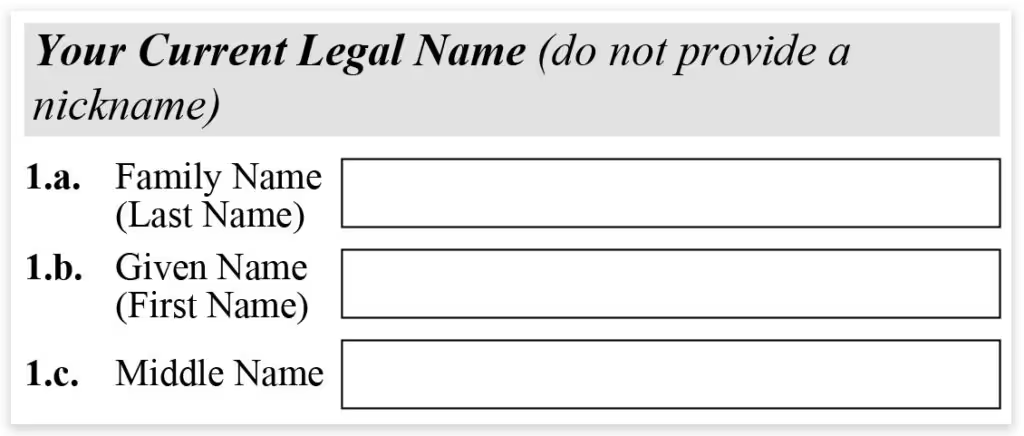
1.a. - 1.c. - This section is just asking for your legal name. Make sure to include your current full legal name. If you have two last names, you should include both.
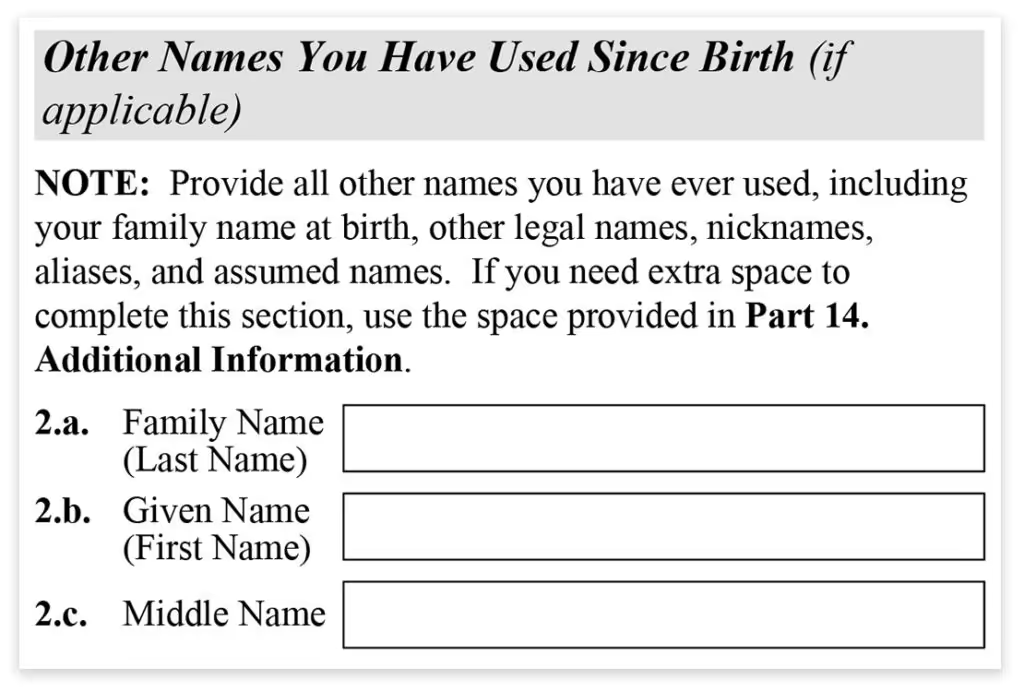
2.a. - 4.c. - This section is asking for other names you have used in your life. This could include your maiden name, name with previous spouses, family name at birth, any nicknames, aliases, or assumed names.
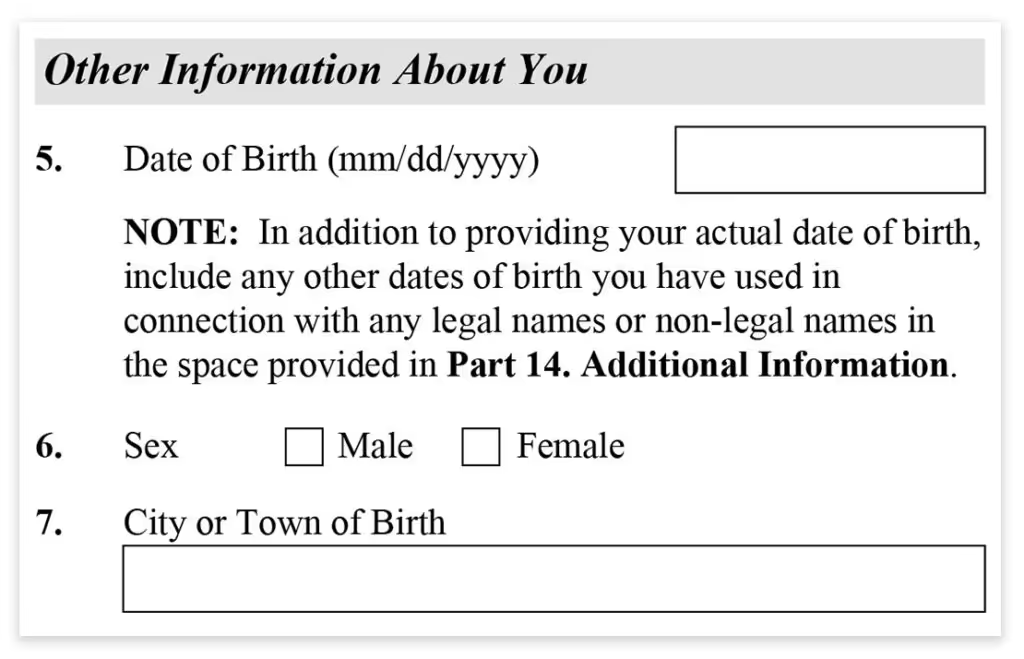
5. This is your date of birth in MM/DD/YYYY format.
6. Here you will choose your sex.
7. This is your city or town of birth. No need to include an address.
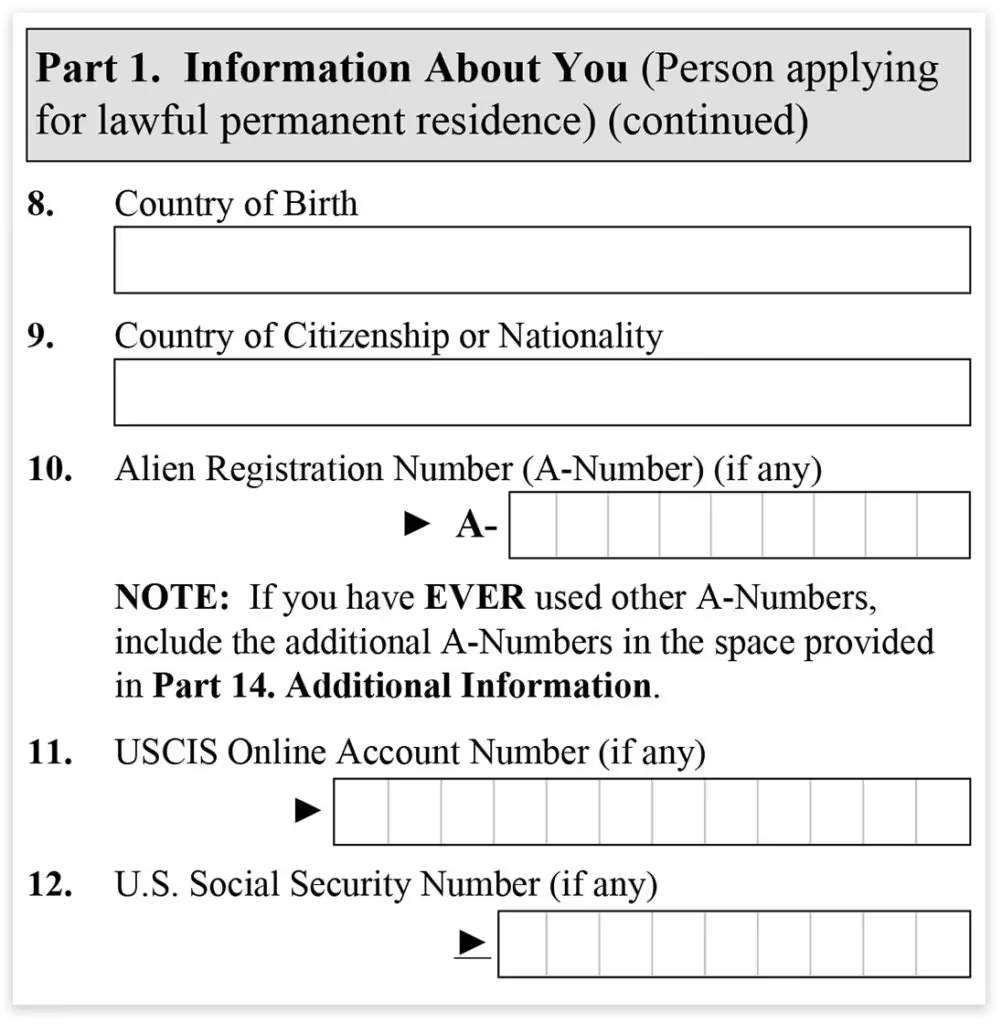
8. This is your country of birth.
9. This is your country of citizenship or nationality.
10. This is your Alien Registration number, if you have one. I can find this number on your work authorization (EAD) card.
11. This is your USCIS online registration number. You will only have this if you have created an account on USCIS.gov.
12. This is your US social security number if you have one.
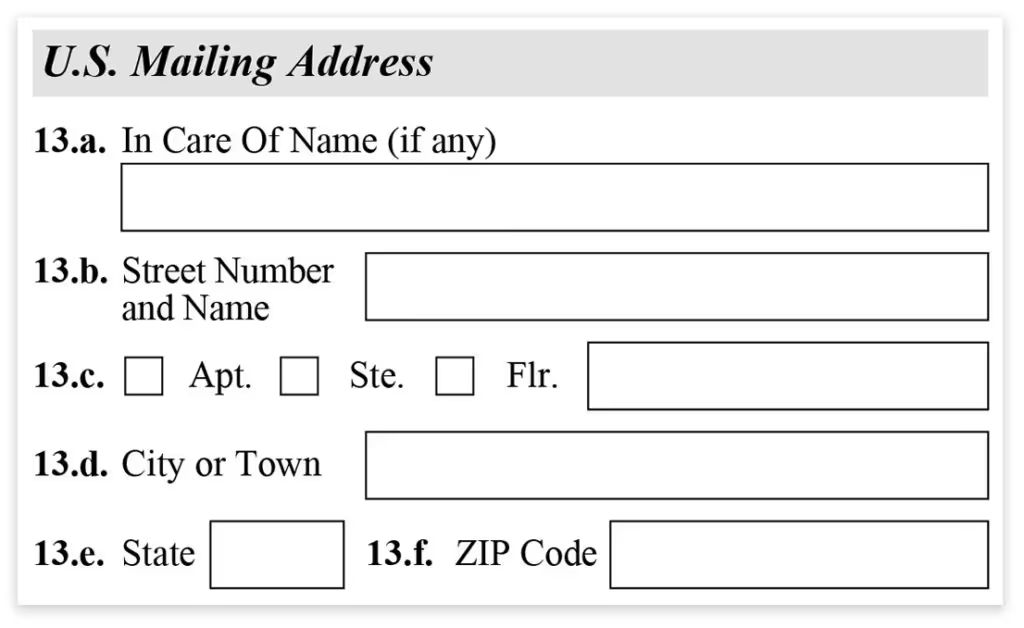
13.a. - 13.f. - This is your current U.S. mailing address. If someone else is receiving your mail for you, their name will be included in 13.a.
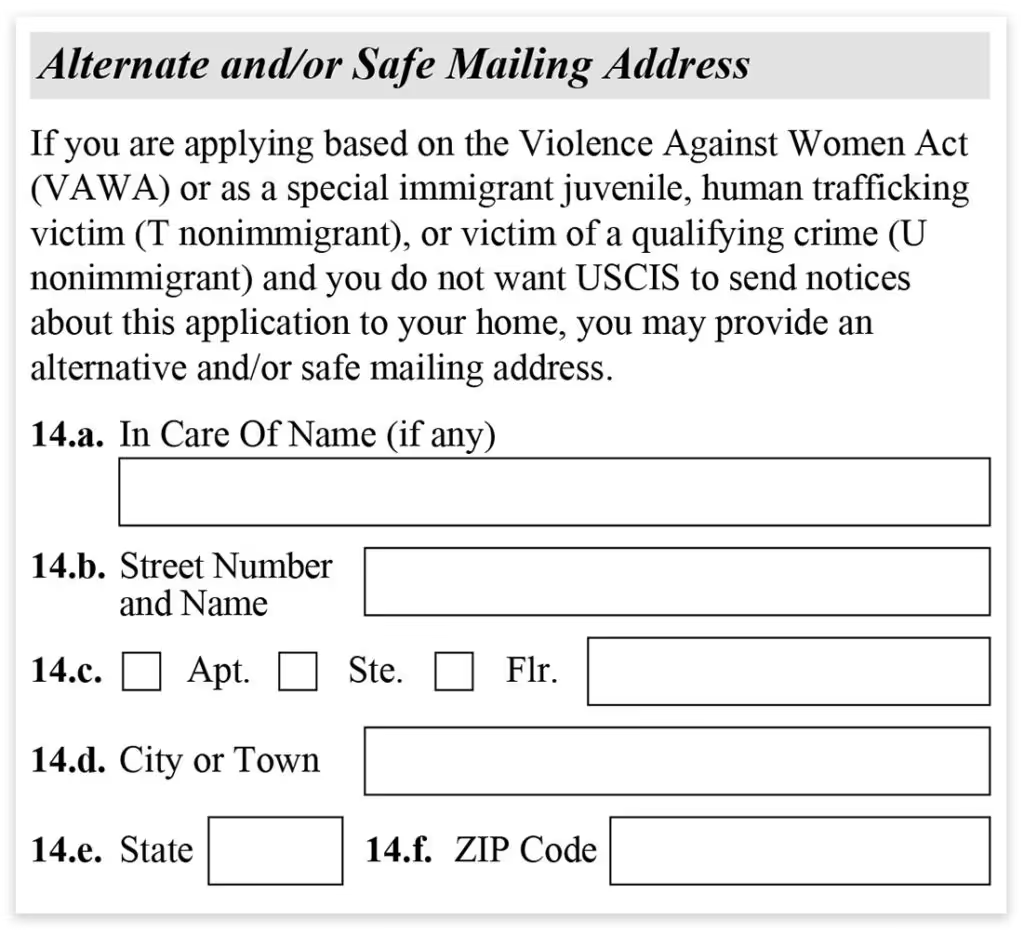
14.a. - 14.f. - This section is for a safe address for immigrants applying under Violence Against Women Act (VAWA), special immigrant juvenile, human trafficking victim (T nonimmigrant), or victim of a qualifying crime (U nonimmigrant). You should fill out this section if you don’t want the USCIS to send notices to your home.
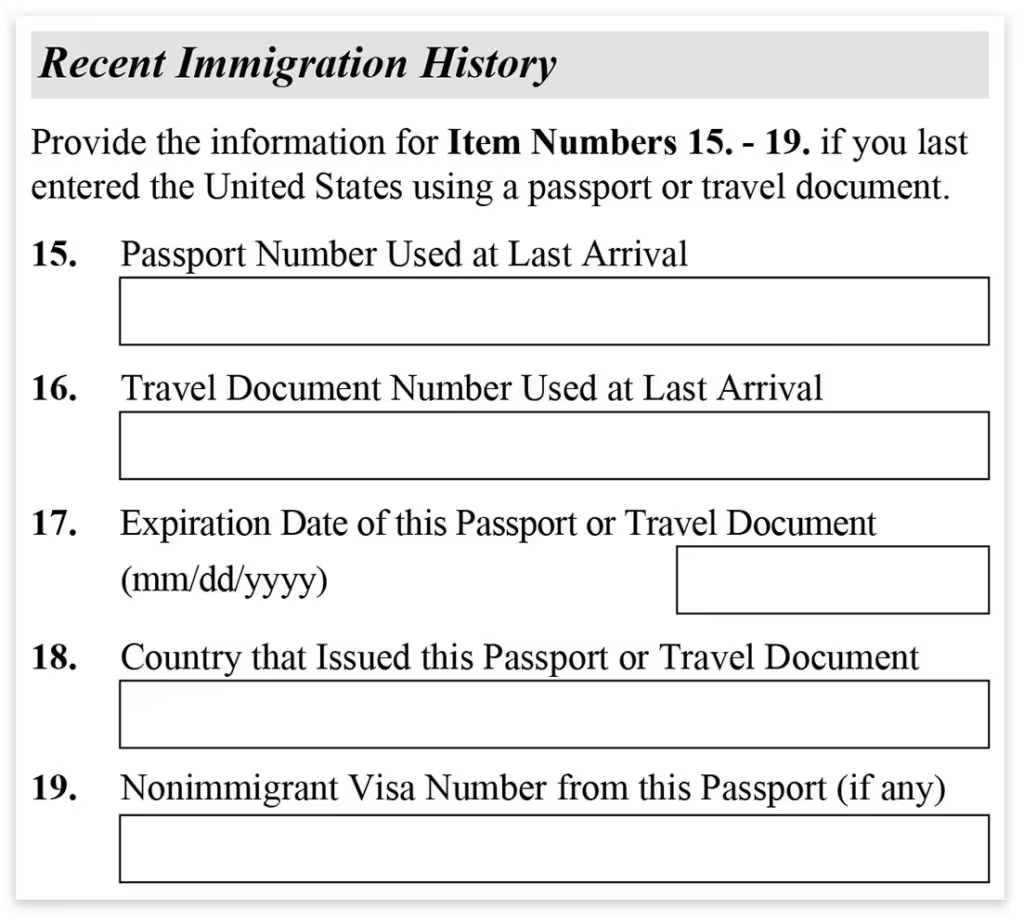
15 - 19 - You will answer these questions if you came into the U.S. with a passport or travel document.
15. This is your passport number.
16. If you came in with a travel permit, you should include its number here.
17. This is the expiration date of your passport or travel document.
18. This will be the country that issued your passport or travel document.
19. If you have a nonimmigrant visa number from this passport, you will enter it here.
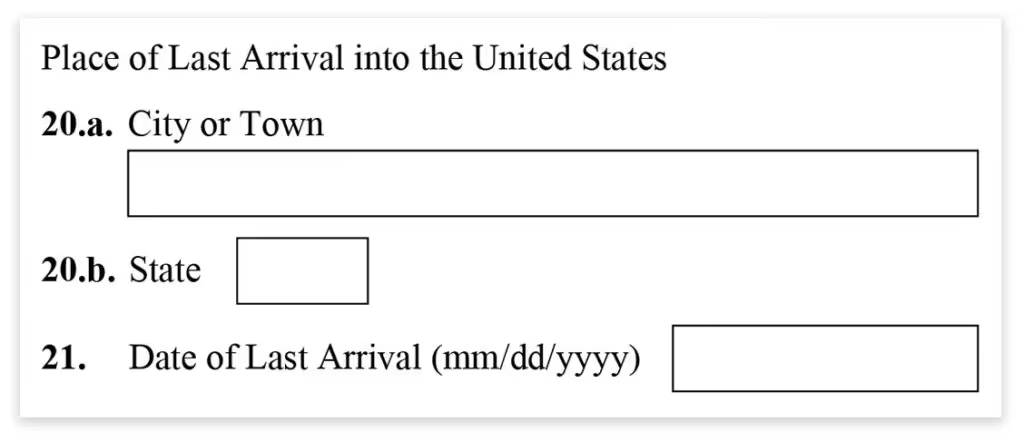
20.a. - 20.b. This is the city or town where you last entered the U.S. If you flew into the country, it will be the city with the airport where you went through U.S. Customs and Border Protection. For example, if you had a layover in the U.S. before reaching your final destination, you would have gone through Customs and Border Protection before your final destination. If you came into the country by land or sea, you will put the city with the border crossing or the city with the nearest border crossing where you arrived. Find your most recent I-94 here.
21. This is the date you last arrived in the U.S.
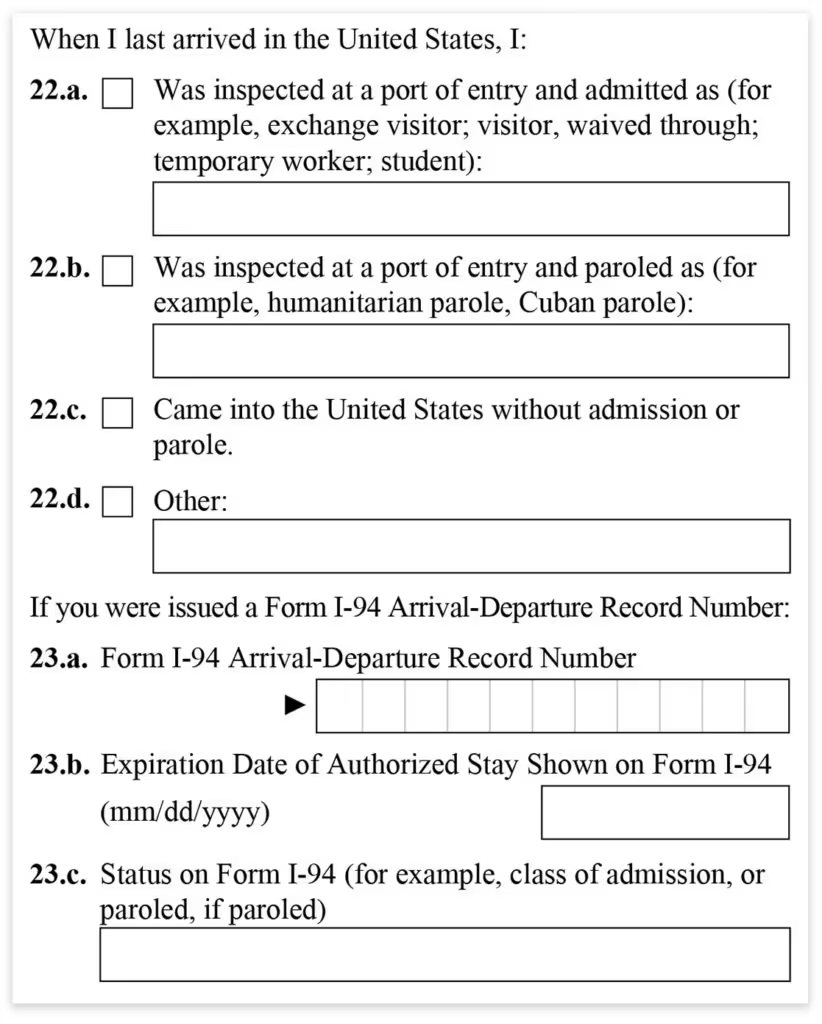
22.a - 22.d. Here you will check if you were inspected by an immigration officer. Being inspected by a U.S. Immigration Officer means that an immigration officer stamped your passport the last time you arrived in the U.S. If you were inspected by an officer, you will also put your admitted status such as F-1 (student) or B-2 (visitor for pleasure). If you don’t know the code for your visa designation, you can describe your status with a term like “student” or “visitor” or “asylee.” You can also find the code on the U.S. visa in your passport. If your status is humanitarian parole or Cuban parole, you will check 22.b. If you came into the U.S. without permission, you will check 22.c. If it were any other circumstance, you will check 22.d. and explain the circumstance. If you are unsure how to answer this question, try filling out your I-485 online with SimpleCitizen.
If you don’t remember any of this information, you can find most of it on your most recent Form I-94 on the Department of Homeland Security’s (DHS) website. Unless you came before April 30, 2013, then you will find form I-94 in your passport.
23.a. Here you will put your I-94 arrival-Departure record number. You can access your I-94 with the link above.
23.b. Here you will put the admit until date found on your I-94. This is almost always different from the U.S. visa found in your passport, so make sure to put the I-94 date. Under some status, mostly students and exchange program visitors, you will not have no exact expiration date. Instead, your I-94 will say “D/S” this stands for duration of status. If your I-94 says “D/S”, you will include that instead of a specific expiration date.
23.c. Here you will put the status indicated on your I-94. This could be your class of admissions or paroled if you are paroled.
If you currently do not have legal status, you should indicate that. If you have overstayed your I-94 expiration date, you should put “overstay”. If you entered without permission, you should put “EWI” (entry without inspection). If this is your situation, you may not be eligible to adjust status if you are the immediate relative of a U.S. citizen. Regardless, you may want to seek legal counsel if this is your situation.
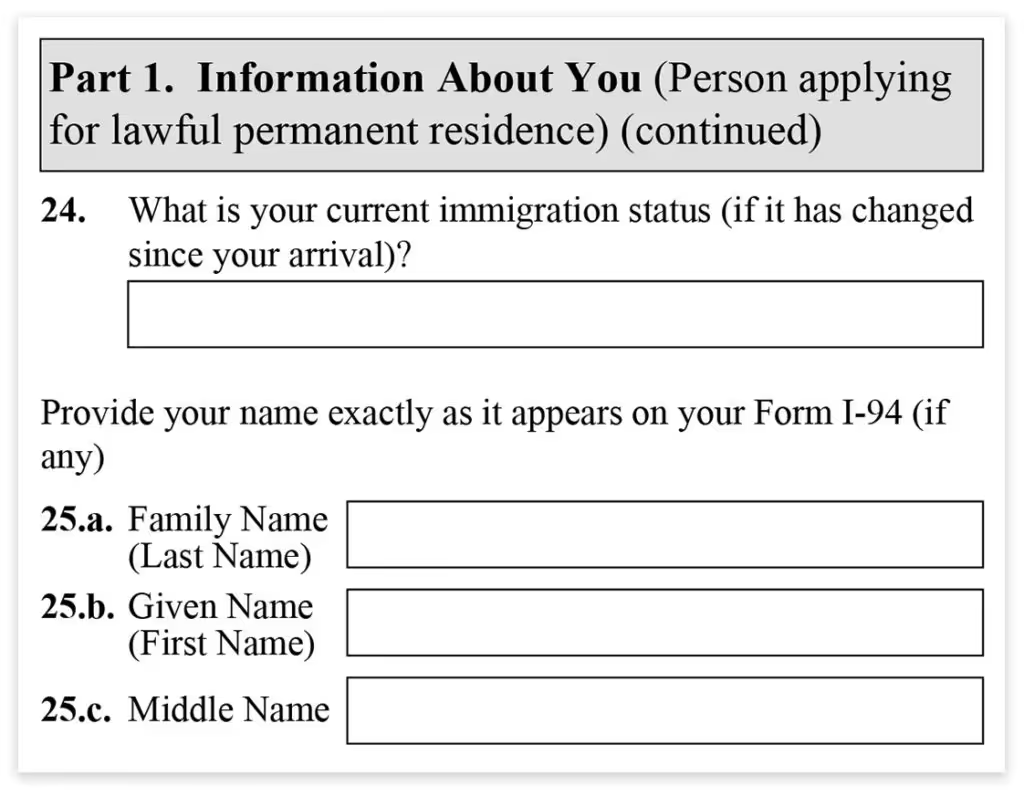
24. If your immigrant status has changed since your arrival, this is where you will include your current immigration status.
25.a. - 25.c. Here you will put your name EXACTLY as it appears on your I-94.
Part 2. Application Type or Filing Category
Page 3
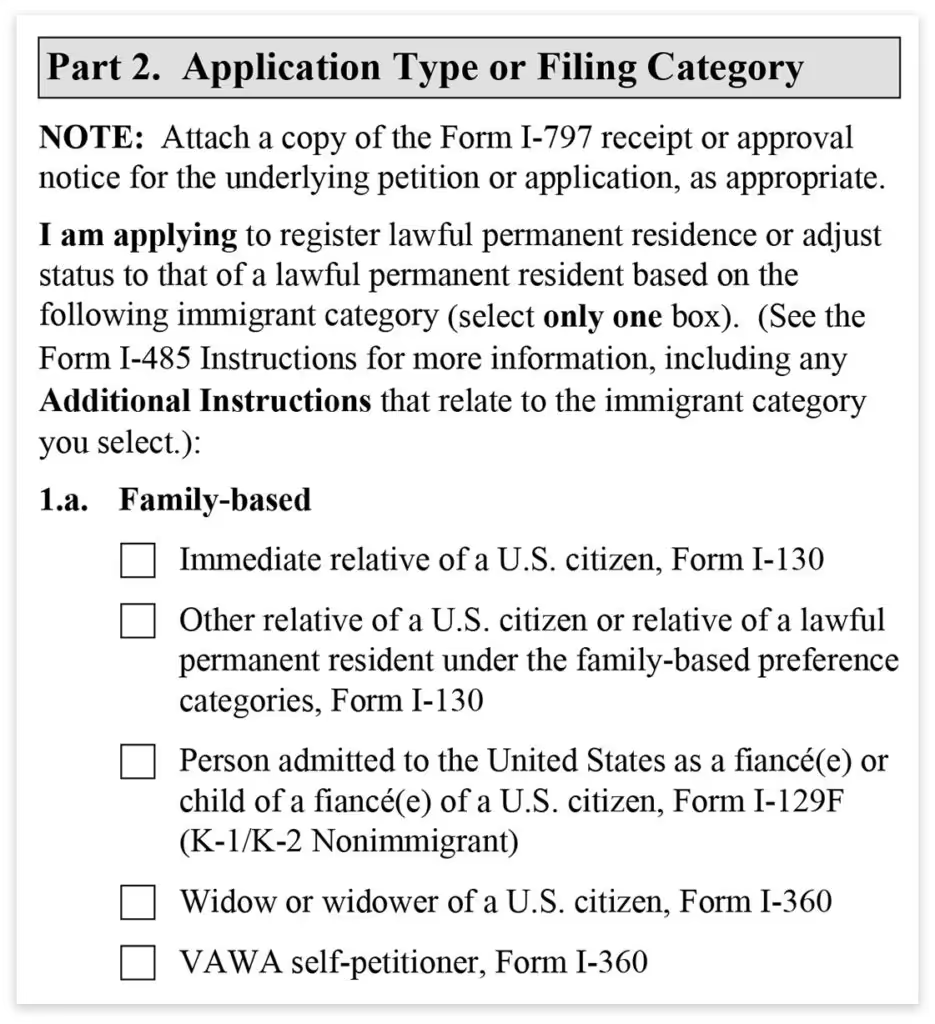
Part 2 asks details about your eligibility for adjusting status. If you have an approved immigrant petition, you should included the Form I-797 receipt or approval notice with form I-485.
1.a. - 1.g. Here is a list of different categories of eligibility. Select the one that applies to you.

2. This most likely does not apply to you. the Immigration and Nationality Act (INA) section 245(i); is an old law that applies to only a select group of people who came into the U.S. without permission. To find out if this applies to you, visit USCIS.gov.
Information About Your Immigrant Category
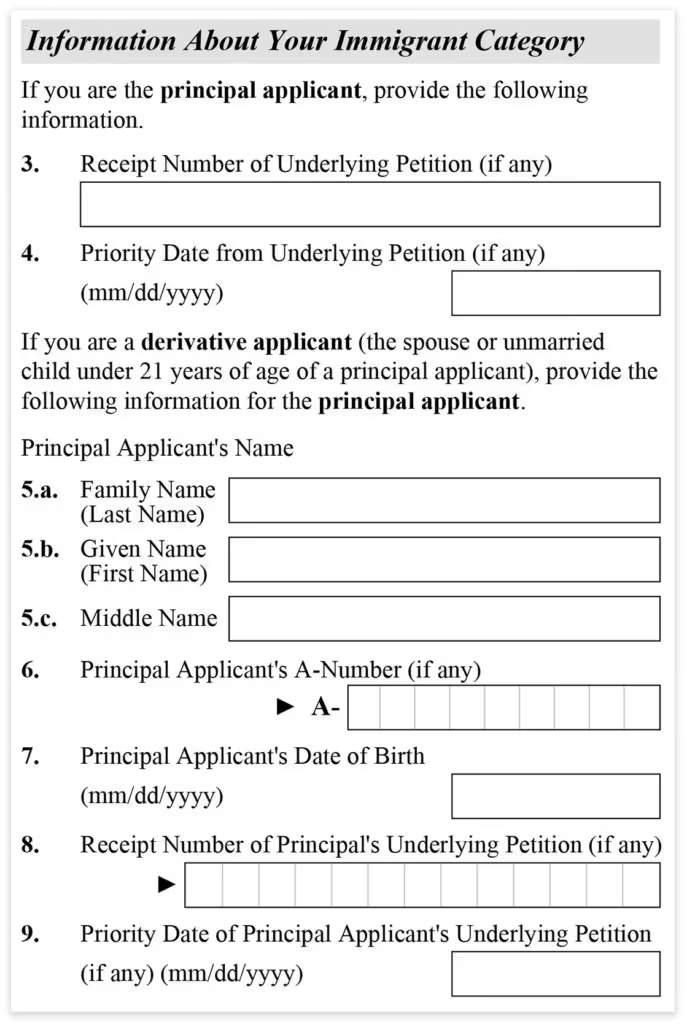
3. If you have an approved petition, you should include its receipt number here. A petition could be an Form I-130, Form I-140, Form I-360, Form I-526, or I-918. The receipt number will be included on the Form I-797 approval notice the USCIS mailed.
If you are filing concurrently (i.e. filling out the petition at the same time as the I-485), question 3 and 4 do not apply to you. Leave it blank.
4. If you have an approved petition, you should include its priority date here.
5 - 9. This section only applies to a derivative applicant. A derivative applicant is an immigrant who didn't need a separate petition rather depends on the petition of a principal applicant. This would most likely be a parent or spouse. In this sections, you will include the information for the principal applicant.
Part 3. Additional Information About you
Page 4
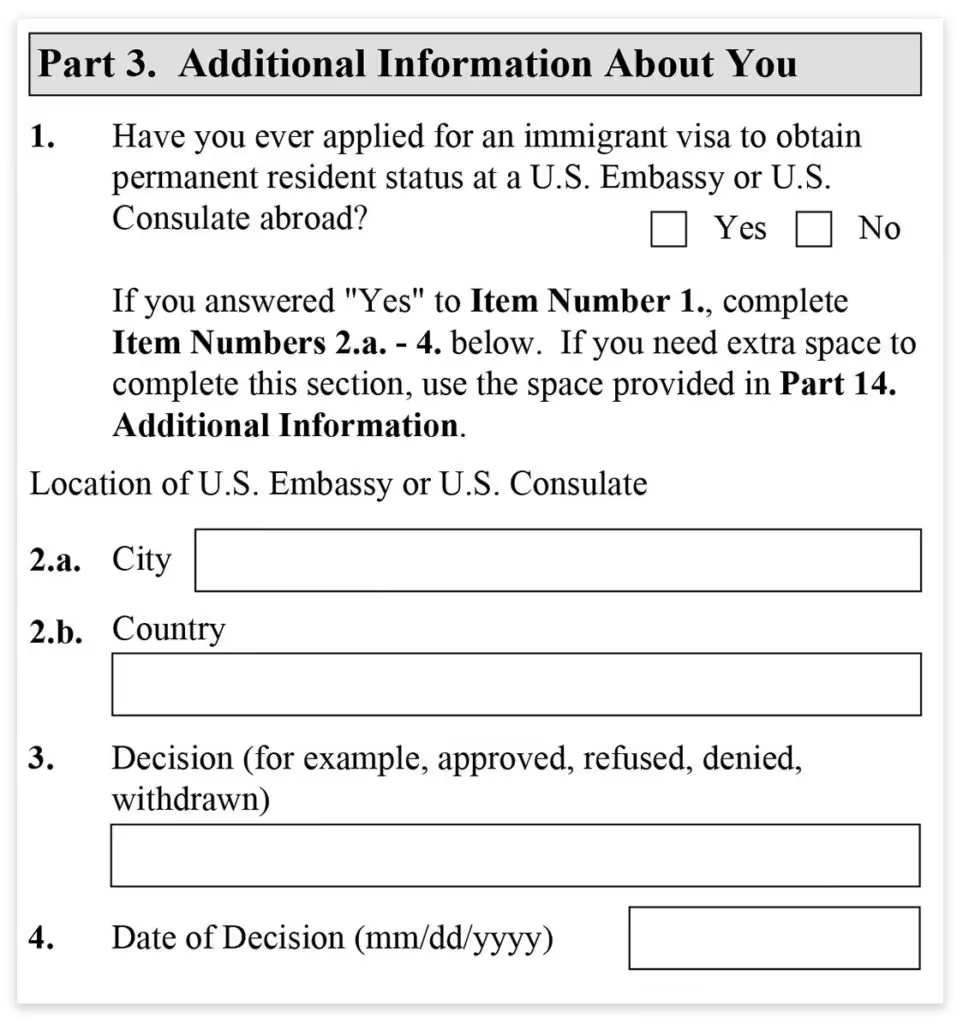
1 - 4. If you have ever applied for an immigrant visa (green card) at a U.S. Embassy or Consulate, you will fill out this section. In question three you will put either approved, denied, refused, or withdrawn. Don’t worry about explaining why the decision was made. That is not necessary.
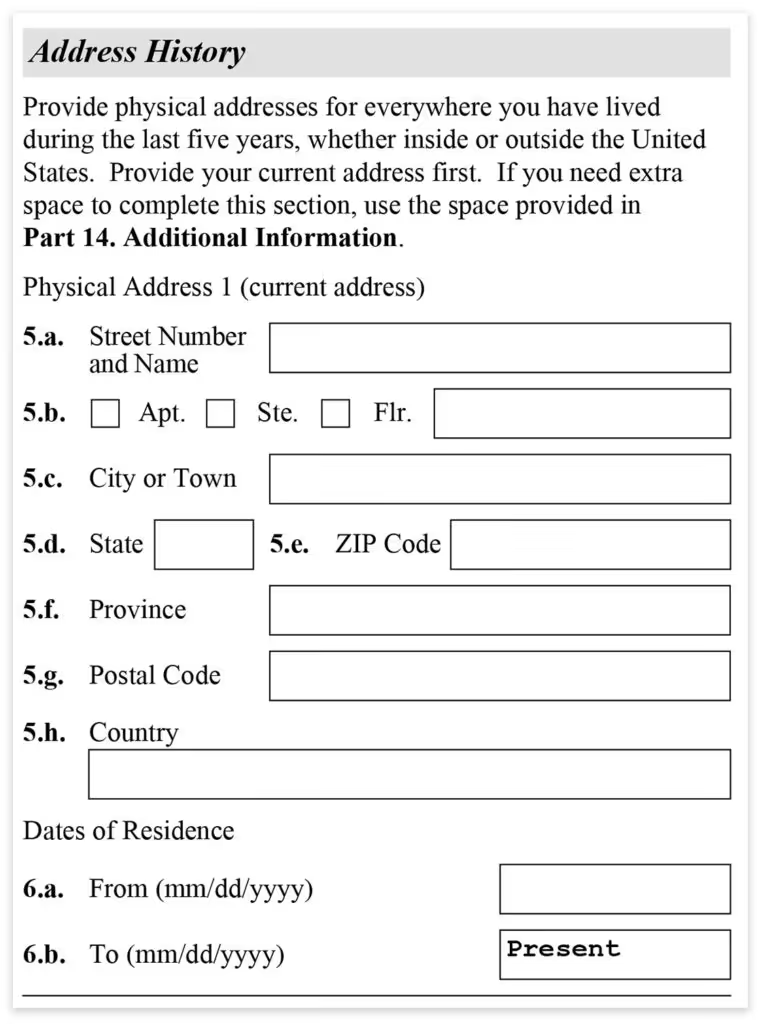
5 - 7. Here you will provide your physical address history for the past five years. Provide your current address first. If you have had more than two addresses, you can include additional information in Part 14. Additional Information. This information is provided so the USCIS can perform a background check, so make sure it is as accurate as possible.
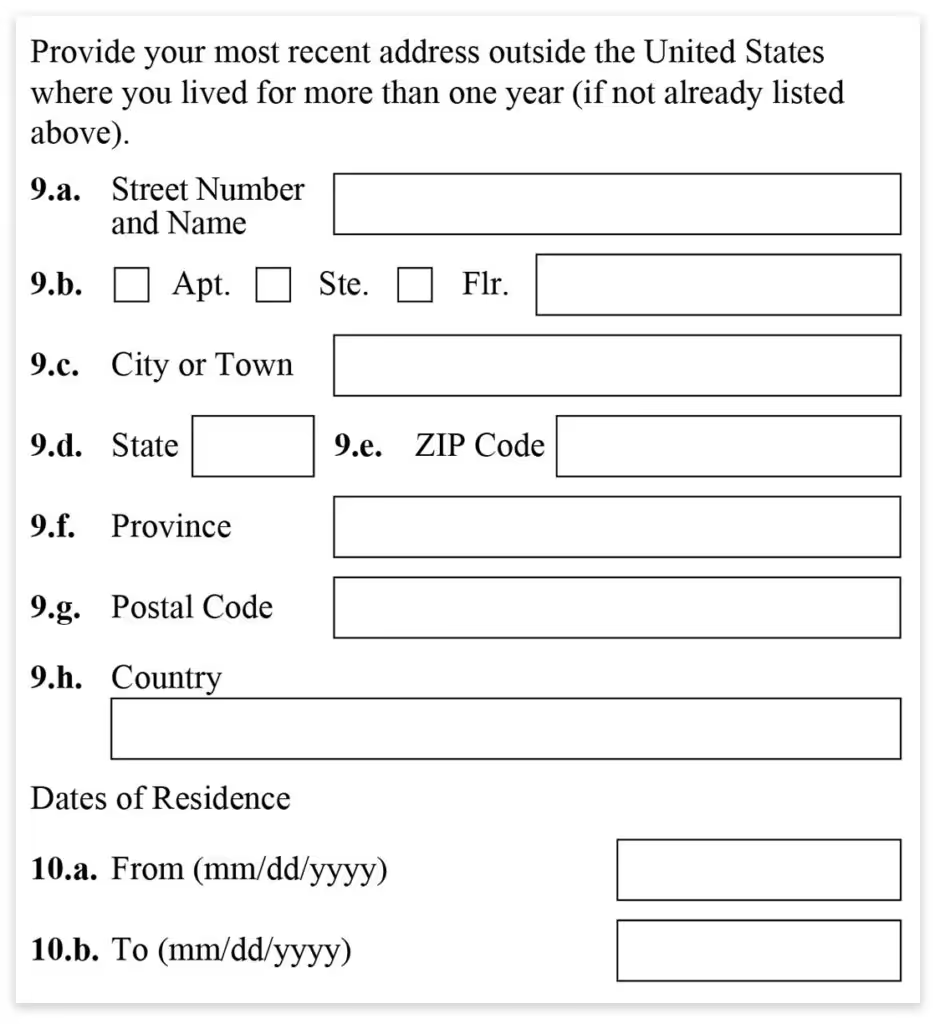
9.a. - 10.b. Here you should provide your most recent address outside the U.S. where you live for more than one year. However, if you have already provided it above, you do not need to include it here.
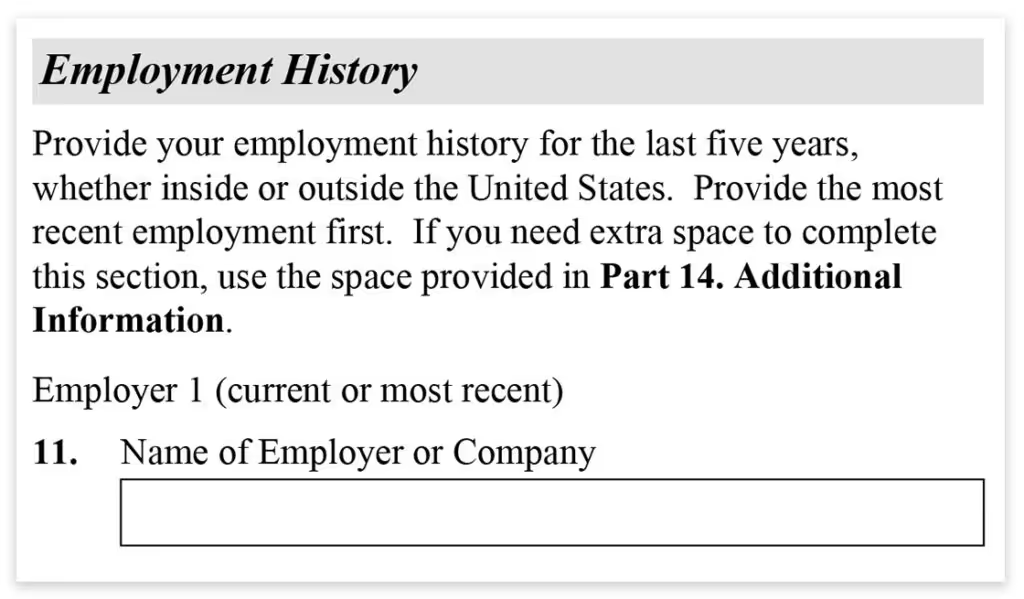
11 - 18.b. - This is also for a USCIS background check. You should provide your 5-year employment history. Again make sure it is as accurate as possible. If you have additional info, you can provide it in part 14. Additional Information. If you have not been working, enter “None” or “N/A”.
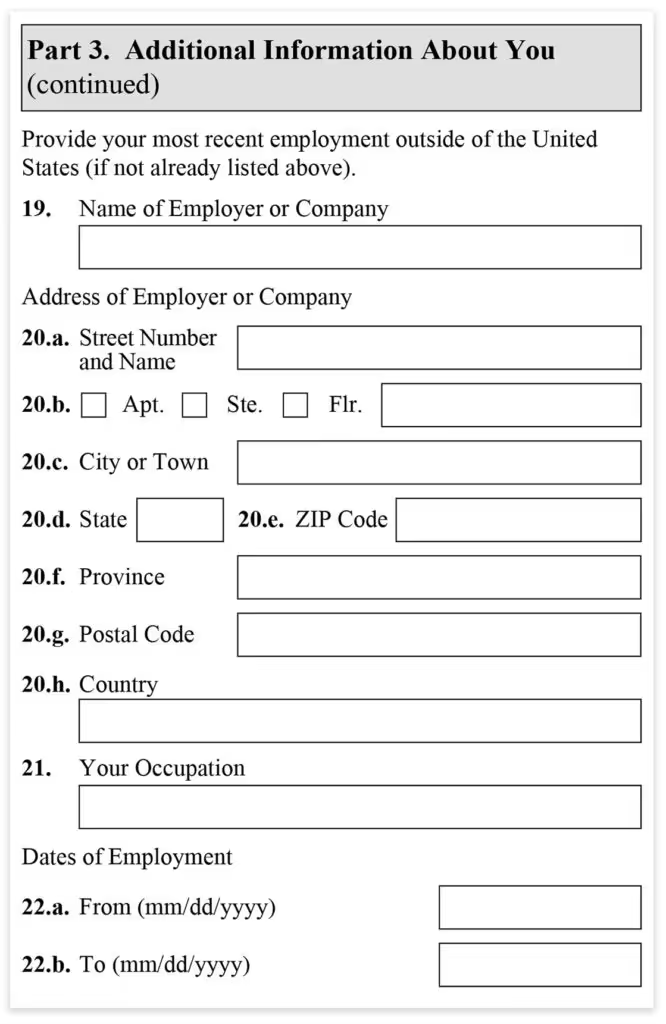
19 - 22.b. Here you should provide your most recent employment (even if you were there less than one year) outside the U.S. if you have not provided it in 11-18.
Part 4. Information About Your Parents
Page 6
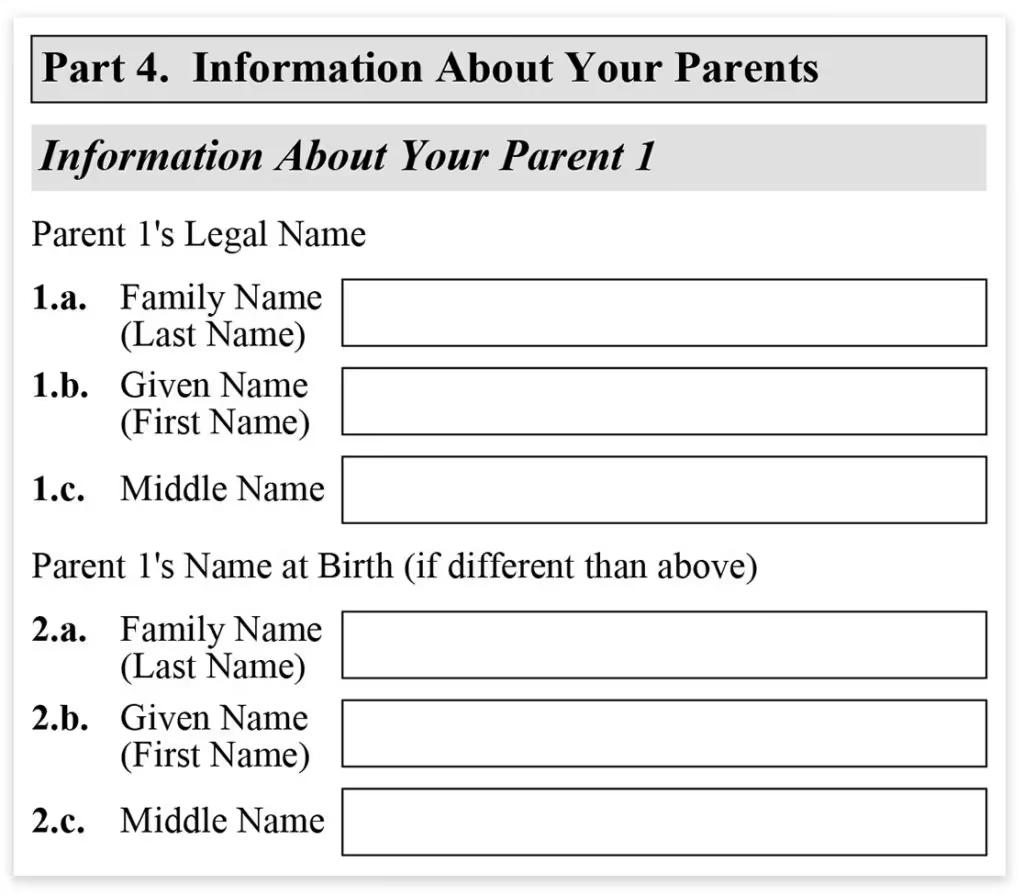
1.a. - 16. Part four asks background information about your parents. If they have passed away, you should answer DECEASED on question 7,8,15, and 16.
Part 5. Information About Your Marital History
Page 7
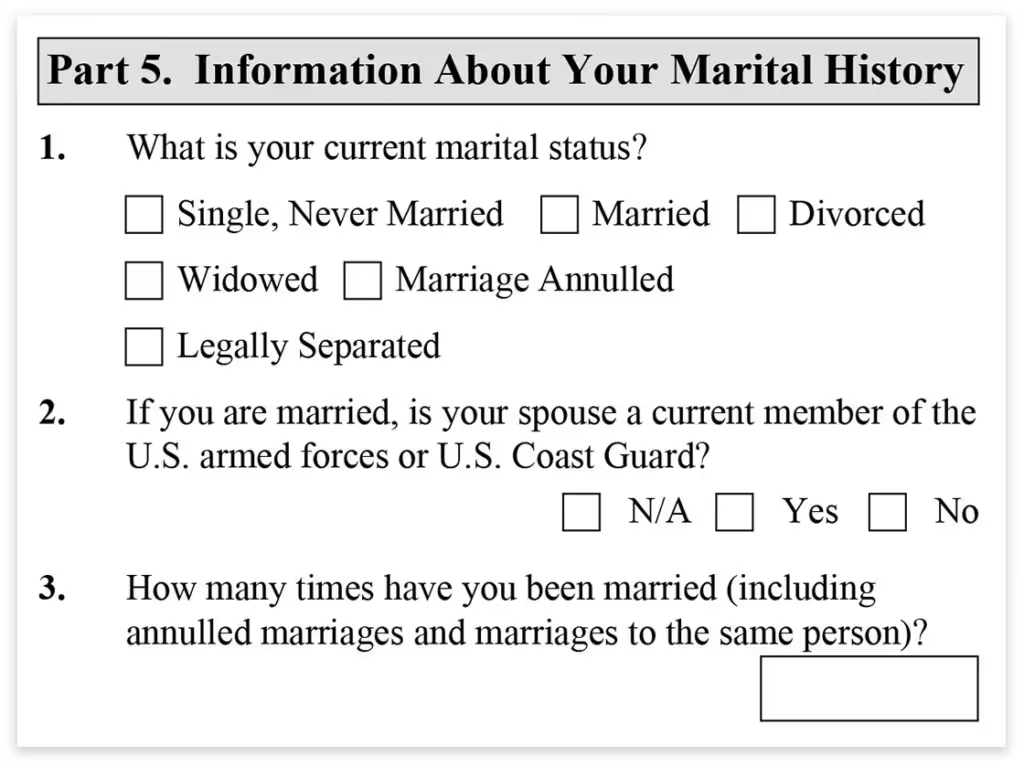
1 - 16.c. Part 5 gathers information about your marital history. This section is particularly important for applicants who are immigrating through marriage. The USCIS wants to verify that you are really eligible.
You will provide information about previous marriages. If you run out of space, again, use Part 14. Additional Information.
Part 6. Information About Your Children
Page 8
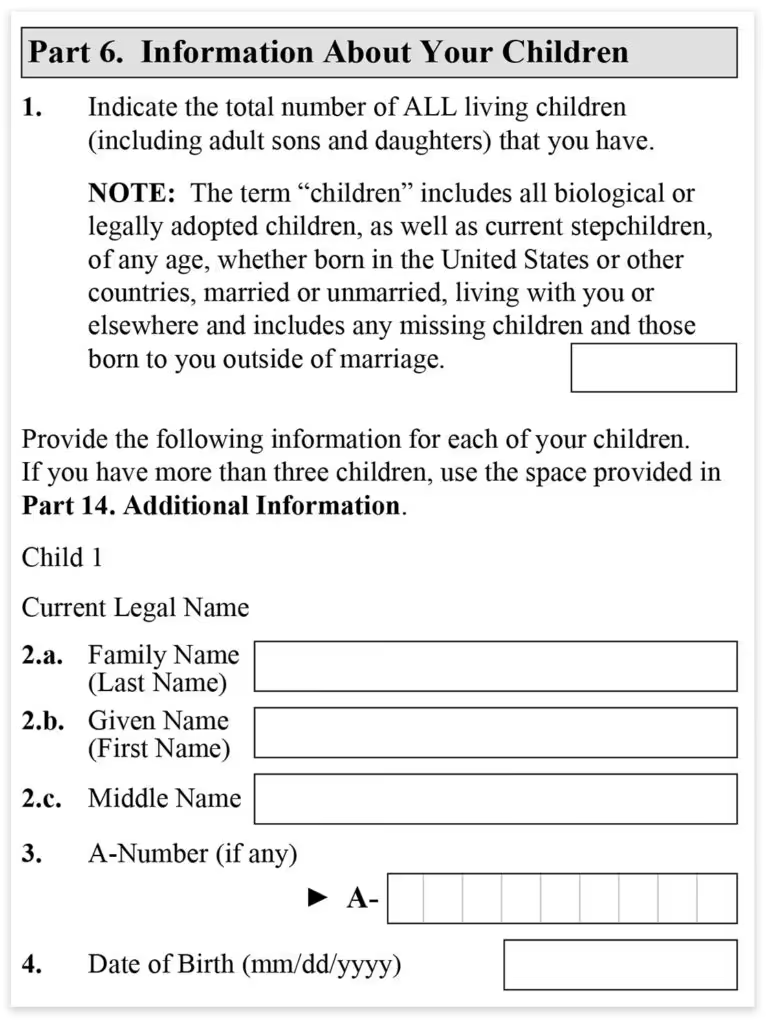
1 - 16. Part 6 is where you provide information about your children. First, you will indicate your total number of living children. You will then provide basic information about them. You should include both adult children and stepchildren here. Failure to do so could create doubt of your relationship if they want to immigrate to the U.S. in the future. If you need more space, go to Part 14. Additional Information.
Part 7. Biographic Information
Page 8
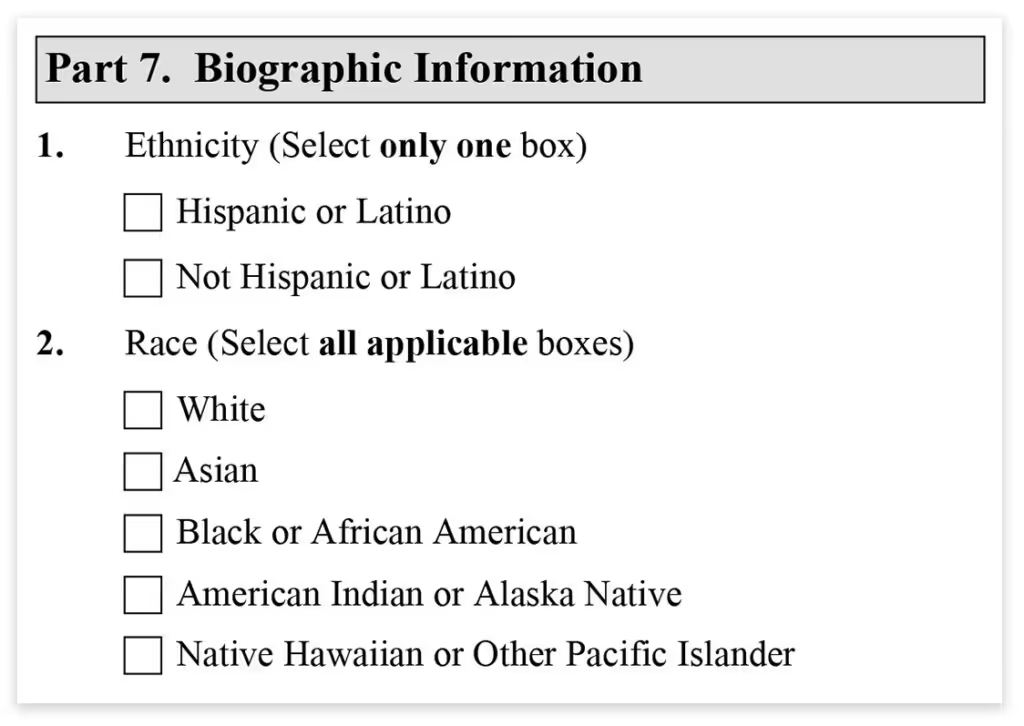
1. In this section, you will add some biographical information. This is so the USCIS can confirm your identity. First you will put if you are hispanic or not. Hispanic or latino is a person of Cuban, Mexican, Puerto Rican, South or Central American, or other Spanish culture or origin.
2. In this question, you will put your race. This can be confusing because there are only a few categories. Here is a guide for the USCIS:
- White is a person having origins in any of the original peoples of Europe, the Middle East, or North Africa.
- Asian is a person having origins in any of the original peoples of the Far East, Southeast Asia, or the Indian subcontinent including, for example, Cambodia, China, India, Japan, Korea, Malaysia, Pakistan, the Philippine Islands, Thailand, and Vietnam.
- Black or African American is a person having origins in any of the black racial groups of Africa.
- American Indian or Alaska Native is a person having origins in any of the original peoples of North and South America (including Central America), and who maintains tribal affiliation or community attachment.
- Native Hawaiian or Other Pacific Islander is a person having origins in any of the original peoples of Hawaii, Guam, Samoa, or other Pacific Islands.
3 - 6. For the remaining questions, you will put your height, weight, eye color, and hair color.
Part 8. General Eligibility and Inadmissibility Grounds
Page 9
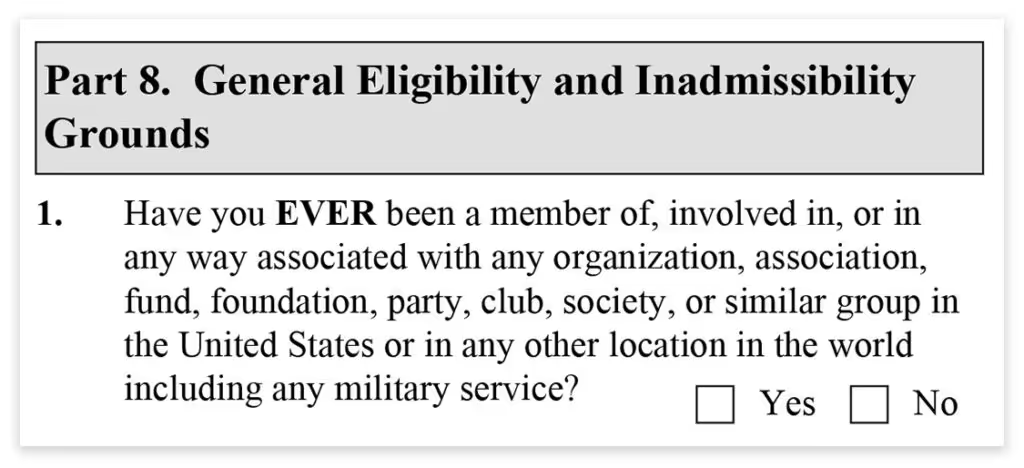
This section is long. Don’t stress though. The purpose of this section is to make sure you have not done anything to make you inadmissible to the U.S. Being inadmissible means you would not be eligible for entrance to the U.S. at all due to crimes, immigration violations, or other reasons. If you have been involved in any organization that promotes violence, you should seek the advice of an attorney.
1 - 13.b. In this section, you will include any organization, association, fund, foundation, party, club society, etc in which you have been involved. This is mostly to determine if you have been involved in a violent organization, but including volunteer or religious organizations can help show the USCIS officer that you are a moral person.
14 - 80.b. Most of these answers should be “no”. However, you have some “yes”. If you have overstayed a visa, you should answer “yes” on question 17. You can then explain the circumstances in Part 14. Additional Information. On question 24.a. -24.c. you may also answer yes and explain the circumstances around your J-1 visa two-year requirement.
You should also disclose all arrest. Even if it was a mistake or for a minor crime, you should include them. You do not have to include diving tickets unless drugs or alcohol was involved or if you were fined over 500 dollars. If you have any arrests, you should attach documentation with your Form I-485.
If you have received public assistance, you could be found inadmissible. If this is your situation, you should consult with an attorney before mailing in your Form I-485.
Remember: Never lie on any immigration form. If the USCIS discovers that you have lied on a form, you can be found inadmissible.
Part 9. Accommodations for Individual with Disabilities and/or Impairments
Page 14
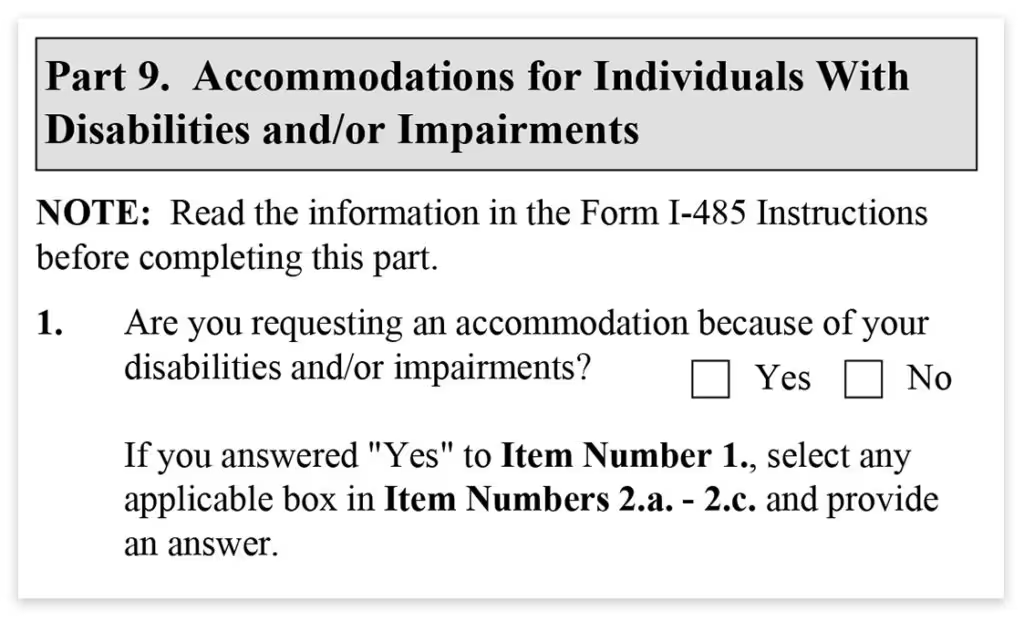
Part nine asks if you have any disabilities or impairments that need accommodations for your interview. This could be a sign language interpreter. You should explain your need in this section.
Part 10. Applicant's Statement
Page 15
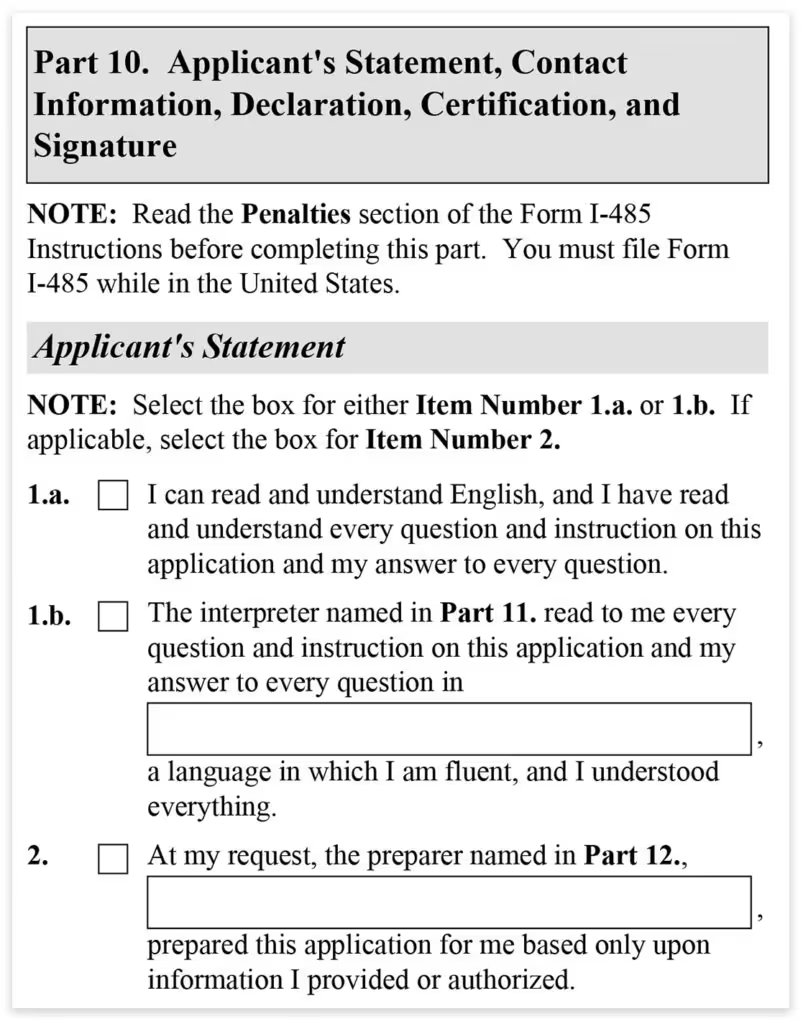
Congratulations, you are about done! Here is where you sign Form I-485. You will also check that you can read and understand English so that they know you understand what you are signing. You will also include your contact information.
Part 11. Interpreter's Contact Information, Certification, and Signature
Page 15
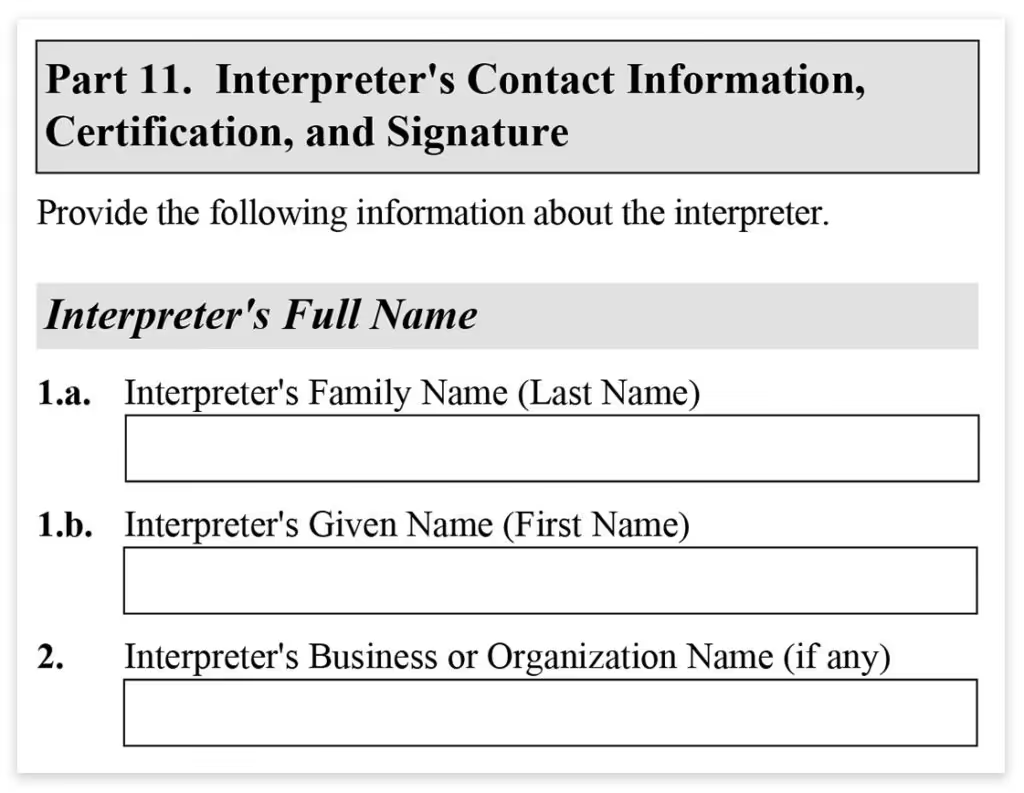
If you don’t speak English and have relied on an interpreter to fill out Form I-485, this is where he/she will sign. You don not need to know English to get a green card, but you will need an interpreter at your USCIS interview.
Part 12. Contact Information, Declaration, and Signature
Page 16
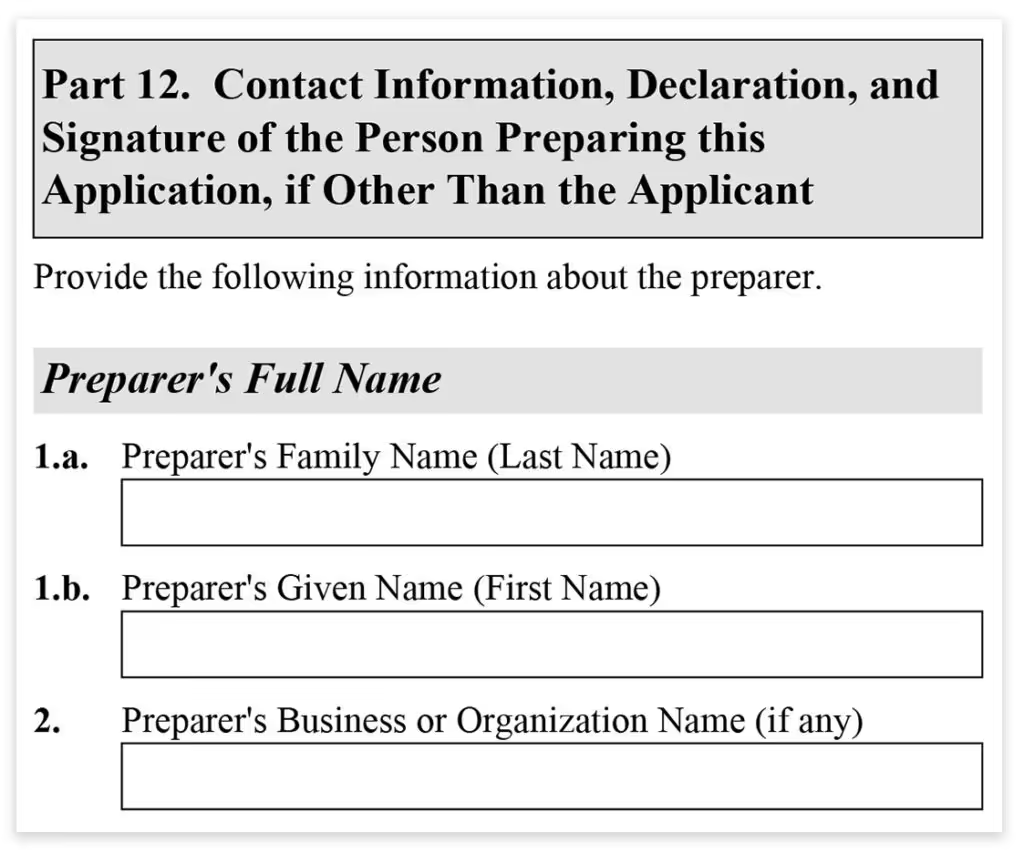
This is where an attorney would include their credentials. You probably will leave this blank considering you’ve been using this step-by-step guide.
Part 13. Signature at Interview
Page 17
This is the section where you will sign at the USCIS interview! Until your interview, leave it blank. Congratulations, you’ve finished!
Perhaps it may be found within a different category.
